|
Blog Feeds
The SakerIndymedia Ireland is a volunteer-run non-commercial open publishing website for local and international news, opinion & analysis, press releases and events. Its main objective is to enable the public to participate in reporting and analysis of the news and other important events and aspects of our daily lives and thereby give a voice to people.
Public InquiryInterested in maladministration. Estd. 2005
Human Rights in IrelandIndymedia Ireland is a volunteer-run non-commercial open publishing website for local and international news, opinion & analysis, press releases and events. Its main objective is to enable the public to participate in reporting and analysis of the news and other important events and aspects of our daily lives and thereby give a voice to people.
Lockdown Skeptics
|
The Jarama at Peace, February 2008 international |
history and heritage |
feature international |
history and heritage |
feature
 Monday February 25, 2008 23:31 Monday February 25, 2008 23:31 by 1 of indymedia by 1 of indymedia

Over 40 people flew out to Madrid last weekend to participate in a number of events centered around a commemoration of Tyrone poet, Charlie Donnelly, who was killed in February 1937 in the latter stages of the Battle of Jarama. Related Links: Connolly Column 70th Anniversary — Wikipedia Article on Charlie Donnelly — Wikipedia Article on the Battle of Jarama Friday The weekend kicked off with a double book launch at the UNESCO Friends’ Club in downtown Madrid. The venue was particularly appropriate. For many years, this was perhaps the only public space in the city where those opposed to the Franco regime could speak openly without fear of arrest. Indymedia spoke to a CNT member just outside their new bookshop, La Malatesta, in Calle Jesús y Maria: ‘In the 60s they were still killing people in the hills, especially in the Asturias. The people there were very isolated. There were no anarchists left to kill in Cataluna. Here in Madrid we were able to meet foreign comrades in the UNESCO club and get information out about the repression’. When did things start to get easier? ‘We were organising neighbourhood meetings in the early ’70, a few years before he [Franco] died. There was still a sense even then that any form of open activity was dangerous. In my home village in Aragón there was certainly nothing happening until ’75, despite the various amnesties that had started to come in 10 years earlier. You could trust nobody’. The books launched were Poemas de Guera y Paz, a translation of International Brigadista Jimmy Jump’s collection of poetry and Un Otoño Para Salvar Madrid, the biography of French IBer Théo Franco by Christine Diger. Over 100 people packed into the meeting room to hear Jump’s son Jim talk about his father’s life and what motivated him to fight for the democratically-elected Republican government against the forces behind Franco’s coup. Present were Bob Doyle and Jack Jones, perhaps the last survivors of the XV International Brigade. Both men were to attend the other events organised over the weekend. Also present was an elderly comrade Flor Cernuda, who after a period of post-war imprisonment in a concentration camp, worked for many years for the underground resistance against Franco’s regime. This reporter’s knowledge of Spanish being barely sufficient to survive 20 minutes outside a tapas bar, her story was sufficiently fascinating to ask her carer to facilitate a brief interview. Her photograph can be seen and her biography and present situation better appreciated in an exhibition curated by Harry Owens, currently on show in the Blanchardstown Library. Saturday The highlight of the weekend was the 1st Memorial March on Saturday morning along a sector of the front line where the British Battalion of the XV Brigade halted an attack on the Valencia road by forces far superior in terms of weaponry and manpower. On February 12 1937, just 600 ill-trained and equipped volunteers from the UK and Ireland moved into positions in olive groves on a ridge overlooking the Jarama valley to the southeast of Madrid. By nightfall the following evening, less than 150 remained alive and capable of defending their positions along a sunken road just behind the ridge. The collapse of the line the next day and the subsequent counter attack organised by Frank Ryan and Jock Cunningham effectively set the front line in cement for the remainder of the war, keeping the Valencia road open to supply the capital. Among the 20 or so Irish killed over the initial 48 hours were Kit Conway, a left Republican from Tipperary, Robert Hilliard, a former Church of Ireland cleric from Kerry and Eamon McGrotty, whose one time membership of the Christian Brothers is often highlighted in the literature as a contrast to Hilliard’s Anglicism. Donnelly fought with the American Lincoln Battalion, who were brought up to the line a week or so later to bolster the much depleted ranks of the Brigade. He died in what must have been a suicidal attack in the same sector of the line as Conway and his comrades. His best known poem, written some weeks before his death, is particularly poignant as his body lay in no man’s land for several days, awaiting the tolerance of crows. The impetus for Saturday morning’s events came from Eddie O’Neill, who organises an annual Charlie Donnelly Writers’ Week in Dungannon. Eddie has been visiting Spain for years and has a deep knowledge and interest in the Civil War and likewise of the battles we are still losing and indeed the lessons that have yet to be learnt. The walk was guided by Seve Montero, a Madrid teacher who approached the landscape with an archaeologist’s eye. Interesting was the use of Google Earth handouts which brought life of sorts to the landscape. We noticed that the new monument to the XV Brigade, on a hillock about 2km behind the ridge where the main battle took place, wasn’t yet depicted. We also noticed that several lines of defensive trenches were now covered with builders’ rubble, seemingly fly tipped into the barranco below. The absence of mapping is perhaps one of the more interesting aspects of Jarama which hasn’t received much attention in the historiography. The only decent map of the sector appears in Frank Ryan’s Book of the XV International Brigade. The map reproduced in Mick O’Riordan’s Connolly Column seems to be a version of that map originally prepared for the brigade by Jason Gurney on the first morning and its inaccuracies are evident. One battlefield monument is located where a position would have given covering fire to the advancing brigade, had the machine guns been fitted with the correct ammunition. This didn’t arrive until the evening of the first day and the attacking fascist troops were halted temporarily when the correct ammunition was brought to the front. The position was captured the following day when an English detachment withdrew without orders from their right flank. Donnelly was commemorated nearby by a minute’s silence and a reading in Spanish and English of The Tolerance of Crows. The walk ended at the new monument to the IBs with a few speeches and a presentation to Bob Doyle and Jack Jones. The only speech with any real political content was that given by Bob who stressed that capitalism had not been defeated in Spain and that the struggle against those in control of power and wealth still continues. He cited Shell’s involvement in Nigeria and stressed that sophisticated PR was now a weapon in their arsenal. He stressed the importance of opposing these forces using different methods to those used in the past. Bob’s speech can be read at the AABI link below. Official Dungannon was represented by the mayor, Cllr. Barry Monteith and the former mayor, Francie Molly MLA (both SF). The local PSOE MP Juan Julián Ramón was heckled briefly but recovered sufficiently to mouth along to the Internationale, which was rendered simultaneously in several languages. The afternoon was spent in a local restaurant El Cid, which also houses a museum of the battle. Presentations were made to several of the organisers of the events of the weekend and this reporter enjoyed discussions with several comrades from the (Irish) republican movement. Some went off afterwards to visit the cemetery where the remains of those who fell at Jarama were unceremoniously dumped in an area of waste ground after the war. A monument has recently been erected there after much lobbying by Bob Doyle and Harry Owens among others. A small group went back up into the hills to look over the site at twilight and Indymedia would like to thank Juan, a comrade from the CNT in Morata who kindly drove us back to the bus later that night. Sunday The PSOE hosted a homage to the International Brigades in a community centre in the Madrid suburb of Vicálvaro on Sunday morning. Proceedings began with a recording of Dolores Ibárruri’s speech given on 1 November 1938 at the IB’s final parade before their stand down in Barcelona. More speeches were delivered by the elected representatives present (both Spanish and Irish) and both Doyle and Jones were presented with flags of the Spanish republic. The latter talked for a moment about the ‘ups and downs’ experienced by the English Labour Party over the past number of years and assured us that under Gordon Brown, the party would be brought back to its socialist roots. Juan Julián Ramón spoke again, this time a little more vociferously to what appeared to be a more elderly and indeed militant local audience. Referring to the recently enabled Law of Historical Memory, the legislative result of the social movement Recuperación de la Memoria Histórica, Ramón told us that the struggle did not finish in Spain in ’39 and that we must all follow the example of Bob Doyle and Jack Jones, a point echoed by the elected representatives from Tyrone. An emotional Internationale was sung again as we departed for the local PSOE offices were food and drink were laid on and more presentations were made to Harry Owens, Eddie O’Neill and the IBers present. The official Dungannon contingent were presented with books on Vicálvaro’s role in the Civil War before heading off with Bob Doyle to the Basque Country.
|























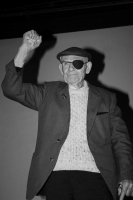


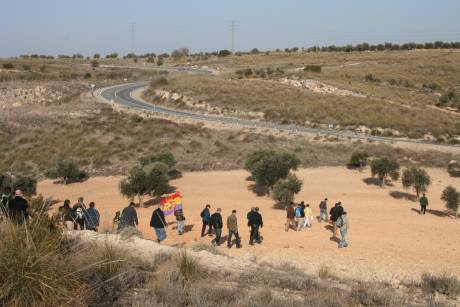
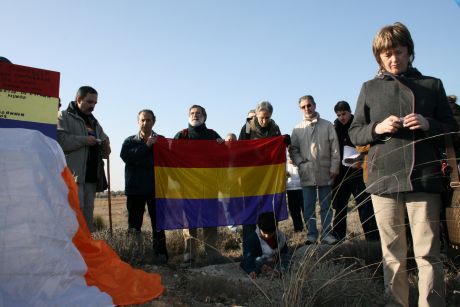
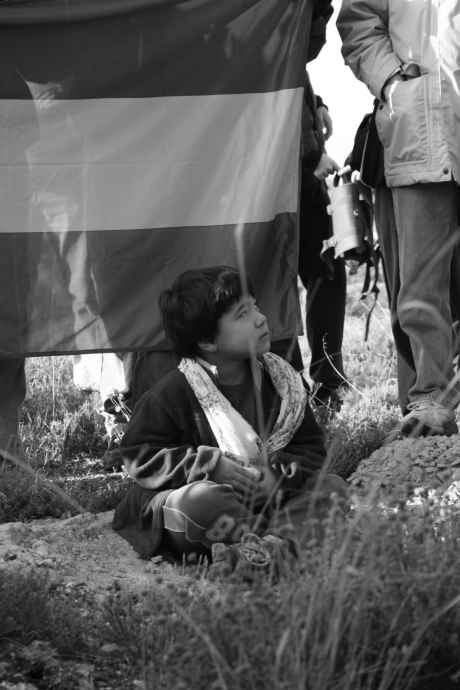

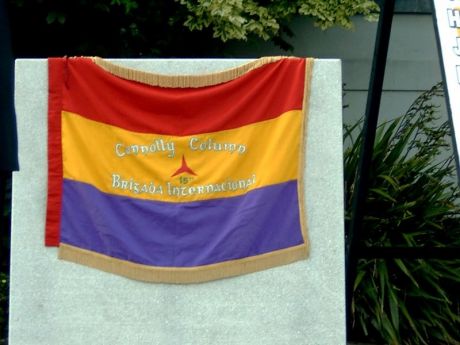
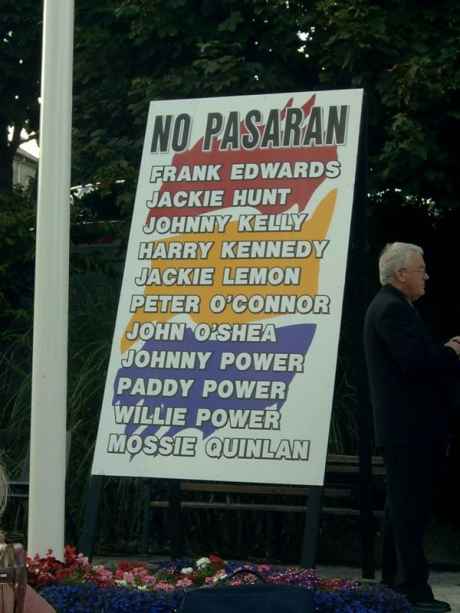
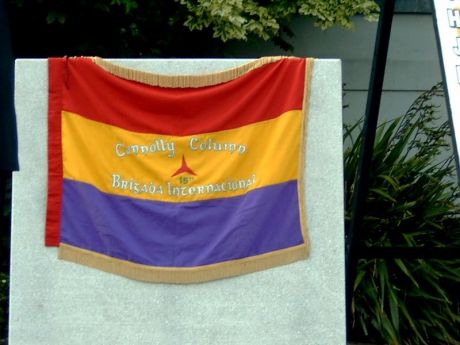
 printable version
printable version

 Digg this
Digg this del.icio.us
del.icio.us Furl
Furl Reddit
Reddit Technorati
Technorati Facebook
Facebook Gab
Gab Twitter
Twitter
View Comments Titles Only
save preference
Comments (18 of 18)
Jump To Comment: 1 2 3 4 5 6 7 8 9 10 11 12 13 14 15 16 17 18A few more shots of Saturday's events at Jarama.
We set off, the new memorial to the IBs on the hill behind
Temporary memorial to Charlie Donnelly. It's hoped to have a proper one by next year
Hombre
The Irish contingent near where Donnelly fell
Over this countryside the British Battalion advanced on 12 February 1937
As the morning wore on, it began to get quite warm and the latter half of the walk was postponed for next year.
Conical Hill (right) and Casa Blanca Hill (left). Collectively known as Suicide Hill. Shot taken from the 'sunken road'
This memorial to Kit Conway and his comrades was recently vandalised
The new plaque to Charlie Donnelly was carried along thw walk
The walk attracted lots of people out from Madrid, including this lot
There was a good sized SF contingent among the Irish
It became hotter towards midday...
Bob Doyle, Jack Jones and a Spanish survivor of the IBs were honoured at the memorial
Bob's speech was the only one that was political
The sun was strong, the air a bit chilly
This man sang an amazing song accompanying himself on a two-stringed homemade fiddle
The Internationale was sung often over the weekend
Saturday's event ended with a feast in El Cid and a presentation to several of those involved in the trip.
Seve Montero, who guided us along the walk
Bob was interviewed by a BBC camera crew
The crowd ate and drank in El Cid in Morata de Tajuna
Harry Owens, Bob Doyle and his grandson Jud
A few shots from Sunday's events.
Bob tells PC how to deal with Shell
No pasaran
Irish group at Vicálvaro
Francie Molloy, Harry Owens and Juan Julián Ramón. The latter personally opened the local PSOE beer dispenser for us
The PSOE attempted to stop the inclusion of the communist party in the political party law established at the transition to democracy. They support the monarchy and describe the use of the republican flag as "pre-constitutional". There are however political parties which use the flag & argue for the establishment of the 3rd republic and have pressured for adoption of laws of memory despite political horse-trading by the PSOE. I reckon the deceased subject of this memorial would have lent his support and name to the true parties or organisations of the left in the Spanish state, not the liberal PSOE which rather like British "new" Labour was once a movement...
information on the forthcoming Spanish election -
indymedia ireland thread - http://www.indymedia.ie/article/85869
wikipedia (english) page http://en.wikipedia.org/wiki/Spanish_general_election%2..._2008
youtube coverage (spanish) - http://es.youtube.com/elecciones08
the website of IU (united left), the republican & communist successors of the 2nd Republic and 3rd largest party of the Spanish state http://www.gasparllamazares.es/
fine documentary with lots of excellent footage from barcelona when the civil war within the civil war happened; stalinists fighting, arresting, killing anarchists to put an end to the then successful anarchist revolution that was barcelona 1936....
Ethel MacDonald: An Anarchist Story:
Ethel MacDonald: An Anarchist Story (watch online or download)
This documentary-drama tells the story of Ethel MacDonald, a remarkable young woman whose name hit the world headlines during the Spanish Civil War. She was hailed as the Scarlet Pimpernel of the workers revolution but has since become something of a forgotten legend.
http://openflv.com/watch?v=OTcyMjc1MQ==&p=0
Ethel MacDonald: review of her life and the film
She was dubbed the Scottish Scarlet Pimpernel for helping innocent prisoners caught up in the chaos of the Spanish civil war. Now the neglected story of Ethel MacDonald, a free-thinking anarchist jailed for her efforts in Barcelona, is to be told in a film marking the war’s 70th anniversary.
http://www.infoshop.org/inews/article.php?story=2005021...27979
I agree with the first coment,the real left in spain is iu(left united),psoe and his right economic politic,supporting the monarchy,not making the family of franco give back all the money and possesions that they stole,torturing in country basque,felipe gonzalez =mr x,psoe and all the money that desappear under their goverment in the 90's,they made the electoral law in favor of big parties so one vote is not one vote in spain, they increase the money that the goverment give every year to the church to 8.000millions not a real laisism even despite the constitution said so,etc,etc.all the things that they made the last 4 years as the gay marrige,take down the franco symbols,some social laws, etc its just because they are in minority and they have to have happy the left,but when they are in power in mayority their politic is very right,they are just pure mafia.
The picture of the PsoE ,aghhhhh,this partie in this day are not socialist,only is a capitalism party.
In this day PsoE only used the repression to the basque country.
this party created the murders scuadres of GAL,state terrorism.
the coment on the machine gun companies capture on the second day , as the fault of an "english unit " withdrawring without autharisation . Tells us more about the authors Lazy nationalist agender than it does about his knowlage of the event !He repeats a 70 year old CPGB cover story for an action that was an uncordinated balls up from the moment the lads climbed down from the trucks at 5 in the morning and had there coffee. In my opinion the only organised thing to happen in the next 48hours.He should lay of the cheap nationalist shots and read a little deeper! P.s i went to event and it was great and i would recommend if you get the chance to go in the future .
I don't have a 'lazy nationalist (presumably of the Irish variety?) agender' and I wouldn't have a lot of time for CPGB/CPI analyses of events either.
As for the initial battle of Jarama being a balls up, the International volunteers advancing on the ridge did stop the Nationalist advance on the Valencia road, which of course contributed to the stalemate on that front for the remainder of the war. Whether that was a good thing or a bad thing, well that's another question.
At this stage I've probably read all of the available primary and secondary sources on the battle and have been lucky enough to talk to a few of those who participated on the Republican side about 20 years ago. In his reference to the CPGB cover story, Dan is presumably referring to Bill Alexander's 1982 account of the battle in his British Volunteers for Liberty, an account commissioned by the CPGB to update the previous official version of events produced by Bill Rust, Britons in Spain written as the war was ending in 1939.
Rust includes Bert Overton in the roll of honour of the British Battalion, XV International Brigade , recording his home town (Stockport) along with the place and year of his death (Brunete, July 1937). Overton does not feature in Rust's account of Jarama but his absence is perhaps that of the proverbial tank in the china shop.
Alexander names and shames Overton, the commander of No. 4 Company. His company was charged on the second day with covering the right flank of the British Battalion (which contained a significant minority of Irish, if that's not being too nationalistic for what, after all is an Irish website). Whatever... the unauthorised withdrawal of his company from their flanking position the following day enabled a Nationalist unit attack the machine gun position from the rear and if the Nationalists had pushed home the advantage, they possibly could have shattered what was left of the IB line. I'd imagine few would disagree with this analysis.
One could on the other hand extend a degree of empathy to Overton, who possibly had received an earlier order from their commander, Tom Wintringham to retire if outflanked or if the casualties were too heavy (the order recorded by Rust, which was returned to Wintringham by a runner on the basis there were too many ifs).
I suppose the classic, and to my mind the most objective account would have to be that contained in Wintringham's English Captain, written in 1941 after the author had broken with the Party. Wintringham commanded the British Battalion for the first two days of the battle and he refers throughout his narrative to Overton as O. (a construct used by several other contemporary writers, presumably in an attempt to avoid embarrassing Overton's family back home as much as to avoid besmirching the memory of a former comrade).
On the first day Overton had panicked under fire and had sent inaccurate information back to the command post from his front line position. Wintringham, with the benefit of hindsight, regretted not relieving him from his post the first evening and may genuinely have been unaware of Overton's mental state (like most of the volunteers there, I'd imagine he was scared shitless).
In any case and for whatever reason, Overton withdrew his company without orders, leaving the flank open and facilitating the capture of the MG company and most of their weapons. From my own point of view Overton's nationality is certainly not an issue. The unfortunate was court-martialled and was killed later on in the war, transporting ammunition to the front line as a member of a punitive unit.
Dan may have culled his own analysis from Jason Gurney's Crusade in Spain, published in 1974. Gurney appears to have had something of a breakdown in the immediate aftermath of the battle and ended up leaving the British Battalion and joining the Americans, who displayed a more open contempt for the domination of the CP. He describes beautifully and well the first morning of the battle, which brought on the subsequent horror.
I suppose it's good that these little controversies are still alive, especially regarding CP accounts and other non-PC histories which in most cases do not overstate the hold Comintern had over the organisation of the IBs and indeed, the execution of the Republican war. However any scholarly reading of Jarama will recognise the obvious ill-preparedness of those on the Republican side while giving credit to the heroism of those who fought and died there.
No Nationalist agenda here then (despite a fair few tricolours in the photographs above: they were there, I didn't like the fact that they were there, but hey, I shot them anyway!).
In all the articles, online pieces etc about Jarama, why does no one ever mention Mossie Quinlan of Waterford. He died there too in February 1937 and his sacrifice was every bit as valid as the names that are always cited.
Liam, I'd fully agree that those of a lesser profile should be rescued from history. Maybe you'd consider researching Mossie yourself? There is little enough on him on the Ireland and the Spanish Civil War site, however fellow Waterford volunteer Peter O'Connor offers a poignant recollection of him in A Soldier of Liberty (1996). Quinlan fought with the British Battalion of the XV Brigade where O'Connor had been among those who had joined the American Lincolns. On 16 February O'Connor came up to the lines at Jarama and hailed him as what was left of his unit was moving to a reserve position behind the front. That was the last he saw of him as Quinlan, seemingly having survived the initial battle, was killed a few days later. As far as I know, he was killed prior to the February 27 attack as his name doesn't appear on a small monument erected to the fallen of the British Battalion after that particular battle. The monument was destroyed by the Nationalists after the war but a single photograph survives. Quinlan is listed in the British roll of honour among the many who fell in February. It's therefore entirely apposite to remember him now.
Thank you for your comments about Mossie. By our comments, we have both helped to remember him a bit. I've read Peter's description of the last time he saw Mossie, waving to him as he marched towards his death, and it always brings a tear to my eye. I had the privilege of knowing Peter well and of working with him in various struggles. I also knew John (Jackie) Lemon very well, who was imprisoned in Burgos with Frank Ryan. Jack had a sharp analytical mind. He always said of Peter that he was one of the very best soldiers of the Brigades and I could well believe it. I met Frank Edwards a few times as well, but he tended to be more reserved.
Mossie Quinlan was a first cousin of my mother. I know from an uncle of mine that he was always a bit of a 'character', with a good sense of humour. He was a member of the Fianna Éireann in Waterford at a time when Frank Ryan was a frequent visitor to the city (He was rumoured to have fallen in love with one of my aunts!). I don't know if Mossie had graduated to the IRA by the time he went to Spain, and I think he worked for a while in an ice cream factory in Britain, and may have come under CP influence there.
For many years, in our family, his name was whispered, and he was referred to as 'poor Mossie'. It took me a long time to find out about him and, ironically, despite my family's opposition, I espoused his socialism, republicanism and internationalism.
I cannot adequately express how proud I am of Mossie and of the sacrifice he made for Spain. As long as I draw breath, he will never be forgotten.
What is widely regarded as the best account of the war is by Antony Beevor. "The Battle For Spain."
Amazon Link:
http://www.amazon.co.uk/Battle-Spain-Spanish-Civil-1936...48321
(The book is acclaimed by BOTH sides in Spain today as being fair and accurate...a miraculous miracle in itself.)
Beevor, of course, also wrote the acclaimed "Stalingrad" :
http://www.amazon.com/Stalingrad-Fateful-1942-1943-Anto...84583
and the equally acclaimed "Berlin, the Downfall":
http://www.amazon.com/Berlin-Downfall-1945-Antony-Beevo...r=1-2
.
The photograph from the Sunken Road has the caption which indicates that the the two hills are Conical Hill and Casa Blanca Hill, collectively known as Suicide Hill.
However I believe the 'hill' on the left is the machinegun trench position viewed from behind. The 'hill' to the right is Overton's trench position again viewed from behind. The latter was also the first Battalion HQ before moving to the Sunken Road.
From Gurney's map Conical Hill is about two km west of where the Sunken Road meets the San Martin Road and just under 1 km from the machinegun position. Conical Hill cannot be seen from the Sunken Road where the photograph was taken.
The back of the Machinegun Trench is about 200 m. west of the Sunken Road and that is more or less indicated on your photograph.
Mike, you're sorta half-right! You can just see the top of Conical Hill peeping over the right-hand shoulder of Suicide Hill if you squint. I've uploaded a better shot where you can see it more clearly. It was visible from Wintringham's first HQ and from the right flank of the MG company however a lot of people who visit the site don't walk it properly and only notice the 'knoll' over by the main road, which they assume to be Conical Hill. Wintringham said it was shaped like a lightshade.
Regarding the position of the MG company, either you're wrong, or we're looking at a different photograph. You can't really treat as accurate the positions on Gurney's map west of the sunken road; the ridge in front of you (and the Conical Hill behind) were occupied by the British Battalion on the first morning and they advanced c. 300m downslope (to the west), before retreating to the Casa Blanca which was attacked by artillery by lunchtime. The MG position was not established until later on that afternoon, to the right of where the photo was taken, around where the makeshift memorial is today. You'll appreciate an excellent field of fire across the eastern slopes on the hills in the photograph, along with a right flank covering the bottleneck valley which faces the 'knoll' just south of the main road. The remains of a stone wall indicate the northern extent of the trench, which has been backfilled over most of its extent.
Overton was to the right, slightly upslope covering the right flank along the sunken road and the valley directly in front. We found a few Maxim shells when fieldwalking there a few years ago. They were of the earlier type, (i.e. not 7.62mm) and of German manufacture. This is surprising as Fry was there for barely 24 hours before the position was overrun. A shell taken back for analysis was returned to the site last year.
There is a trench surviving where you've indicated the position of the MG company, slightly over the ridge in the photograph. I'd imagine this was constructed later by the Nationalists as the little valley in the photograph was effectively no man's land for the remainder of the war. The trench lies just below what remains of the Casa Blanca.
As a matter of interest, the area in the photo was under olives in 1937. After the war, there was so much metal in the trees that they were all chopped down and never replanted. I heard recently that the landowner is going to replant the area with olives this year. This should make the battle more 'immediate', as the activity over the first three days really took place over a small area, more or less that in the photograph. If Gurney's map is superimposed on modern maps using known points, the Casa Blanca positions are up to 500m west of where they should be. A good walk around will show you the real lay of the land.
Conical Hill to the northwest of Suicide Hill
..is excellent. What i liked was how he pointed out the microcosm of the Spanish situation in relation to the European and global macrocosm emerging in its train.